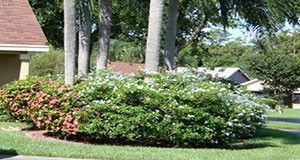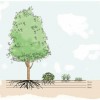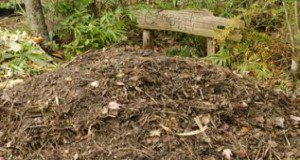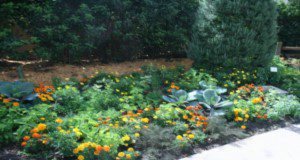This new 7-page publication of the UF/IFAS Environmental Horticulture Department is intended to educate homeowners on environmentally friendly ways to enhance soil fertility for vegetables, herbs, and fruits in the home landscape. It discusses strategies for recycling nutrients in place or via composting systems to create productive edible landscapes with less waste. Adopting these methods into your landscape maintenance routine will build organic matter and add nutrients to the soil naturally. Written by Terra Freeman, Tiare Silvasy, Lynn Barber, Tom Wichman, Esen Momol, Tina McIntyre, Jacqlyn Rivas, and Jen Marvin.
https://edis.ifas.ufl.edu/ep599
Tag: Esen Momol
Edible Landscaping Using the Nine Florida-Friendly LandscapingTM Principles
Maintaining edible landscapes in a way that protects the environment is an important concern for protecting Florida’s water quality. The objective of this new 7-page publication is to introduce the framework of the Florida-Friendly Landscaping™ principles and apply the principles to guide decisions about Best Management Practices (BMPs) for care of edible landscapes. Written by Tiare Silvasy, Lynn Barber, Esen Momol, Tina McIntyre, Tom Wichman, Gail Hansen, Jen Marvin, Terra Freeman, Joseph Sewards, Wendy Wilber, and Jacqlyn Rivas.
https://edis.ifas.ufl.edu/ep594
Floridians' Engagement in Landscape Best Practices to Protect Water Resources: Information from a 2018 Survey
Extension programs are most effective when informed by a deep understanding of the target audience. To guide programs in Florida’s managed landscapes, especially pertaining to water quality and conservation, faculty from the UF/IFAS Center for Landscape Conservation and Ecology conduct an annual statewide survey. The survey gathers data that includes common landscape elements, neighborhood characteristics, engagement in irrigation and fertilizer best practices, and learning preferences. This new 5-page publication of the UF/IFAS Department of Agricultural Education and Communication presents highlights from the 2018 statewide survey with recommendations for how to use the information. Written by Laura A. Warner, Esen Momol, Claire Lewis, Tom Wichman, Wendy Wilber, and A. J. Reisinger.
https://edis.ifas.ufl.edu/wc345
Florida-Friendly Landscaping Guidelines for Community Associations: Considerations for Selecting a Landscape Contractor and Writing an Effective Landscaping Contract
Florida-Friendly Landscaping protects Florida’s unique natural resources by conserving water, reducing waste and pollution, creating wildlife habitat, and preventing erosion. This 12-page document will help the reader with selecting and writing a landscape contract that follows Florida-Friendly Landscaping principles. Written by Adam Dale, Claire Lewis, Esen Momol, Don Rainey, John Bossart, C. J. Bain, Jen Marvin, Lynn Barber, Norman Leppla, Gary Knox, and Thomas T. Ankerson and published by the UF/IFAS Environmental Horticulture Department, June 2018.
http://edis.ifas.ufl.edu/ep347
Encouraging Landscape Water-Conservation Behaviors: Applying Audience Segmentation to Water Conservation Activities in the Landscape—Defining Segments of the Florida Homeowner Audience and Implications for Extension Programming
This is the second publication in a series focusing on encouraging water conservation among Florida residents who use irrigation in their home landscapes. This six-page fact sheet examines one approach to segmenting Florida residents who use irrigation in the home landscape. It also describes how segmentation can be used to encourage water conservation practices. Written by Laura A. Warner, Emmett Martin, Alexa J. Lamm, Joy N. Rumble, and Esen Momol and published by the Department of Agricultural Education and Communication.
http://edis.ifas.ufl.edu/wc200
Encouraging Landscape Water-Conservation Behaviors #5: Segmenting the Audience Based on HOA Status

The newest article in the Encouraging Landscape Water-Conservation Behavior series, this six-page fact sheet provides Extension professionals with information on segmenting audiences based on their home owner association status. It provides data that shows how HOA membership potentially affects the barriers that households face when adopting conservation measures and explains how Extension professionals should use this information to enhance programming by strategically planning programs based on the similarities between clients.Written by Laura A. Warner, Alexa J. Lamm, Emmett Martin, Joy N. Rumble, and Esen Momol, and published by the Department of Agricultural Education and Communication.
http://edis.ifas.ufl.edu/wc246
Perceptions of Florida-Friendly Landscapes: Linking Visual Quality and Environmental Health through Landscape Codes

Early efforts to promote Florida-Friendly landscapes emphasized the use of drought-tolerant plants, which created a negative association with a visually unappealing landscape. This has hampered the promotion of FFL yards and the adoption by homeowner associations. But recently many homeowners are rethinking their landscape maintenance and plant choices and HOAs are considering promoting environmentally friendly landscapes but express uncertainty about recommending FFL because of the need to maintain visual quality. We conducted a study to address both groups’ concerns and help develop FFL-oriented landscape codes that meet both groups’ needs. This 7-page fact sheet was written by Gail Hansen, Laura Warner, Paul Monaghan, Emily Ott, Tim Fogarty, Claire Lewis, and Esen Momol, and published by the UF Department of Environmental Horticulture, April 2015.
http://edis.ifas.ufl.edu/ep519
The Role of Soil Management in Minimizing Water and Nutrient Losses from the Urban Landscape
 Soil is the most important building block of a healthy, attractive landscape, serving many important physical, chemical, and biological functions. Soil provides a physical substrate for plant support and holds nutrients and water for plant use. It also facilitates groundwater recharge (water moving from surface water to groundwater) and provides long-term storage for organic matter. Soil also provides a habitat for microorganisms that aid in the transformation and availability of nutrients. Soil is an integral part of any ecosystem, but urbanization often changes soils in ways that negatively affect plant development. Soils in urban areas may have reduced water infiltration, resulting in increased runoff and increased potential for nutrient losses. Homeowners in urban areas often overcompensate for poor planting conditions by applying inappropriate amounts of fertilizer and water. These practices eventually lead to nutrient losses through stormwater runoff or soil leaching, and these lost nutrients negatively impact groundwater and ecosystems in nearby springs, streams, and water bodies. This 6-page fact sheet was written by George Hochmuth, Laurie Trenholm, Esen Momol, Don Rainey, Claire Lewis, and Brian Niemann, and published by the UF Department of Soil and Water Science, November 2013.
Soil is the most important building block of a healthy, attractive landscape, serving many important physical, chemical, and biological functions. Soil provides a physical substrate for plant support and holds nutrients and water for plant use. It also facilitates groundwater recharge (water moving from surface water to groundwater) and provides long-term storage for organic matter. Soil also provides a habitat for microorganisms that aid in the transformation and availability of nutrients. Soil is an integral part of any ecosystem, but urbanization often changes soils in ways that negatively affect plant development. Soils in urban areas may have reduced water infiltration, resulting in increased runoff and increased potential for nutrient losses. Homeowners in urban areas often overcompensate for poor planting conditions by applying inappropriate amounts of fertilizer and water. These practices eventually lead to nutrient losses through stormwater runoff or soil leaching, and these lost nutrients negatively impact groundwater and ecosystems in nearby springs, streams, and water bodies. This 6-page fact sheet was written by George Hochmuth, Laurie Trenholm, Esen Momol, Don Rainey, Claire Lewis, and Brian Niemann, and published by the UF Department of Soil and Water Science, November 2013.
http://edis.ifas.ufl.edu/ss593
Maximizing the Benefits of Reclaimed Water for Irrigating the Landscape and Protecting the Environment
 Reclaimed water is water that has been treated in municipal wastewater facilities and is safe to use for designated purposes, including residential landscape irrigation. “Water reuse” is the term used to describe the beneficial application of reclaimed water. Approximately 663 million gallons of reclaimed water are used daily in Florida. Florida is a national leader in using reclaimed water, and in 2006 Florida’s reuse program received the first U.S. Environmental Protection Agency Water Efficiency Leader Award. Using reclaimed water in Florida meets a state objective for conserving freshwater supplies, and preserves the water quality of rivers, streams, lakes, and aquifers. This publication discusses the benefits of using reclaimed water to irrigate the landscape and explains how using reclaimed water helps to protect the environment. This 4-page fact sheet was written by George Hochmuth, Laurie Trenholm, Don Rainey, Esen Momol, Claire Lewis, and Brian Niemann, and published by the UF Department of Soil and Water Science, November 2013.
Reclaimed water is water that has been treated in municipal wastewater facilities and is safe to use for designated purposes, including residential landscape irrigation. “Water reuse” is the term used to describe the beneficial application of reclaimed water. Approximately 663 million gallons of reclaimed water are used daily in Florida. Florida is a national leader in using reclaimed water, and in 2006 Florida’s reuse program received the first U.S. Environmental Protection Agency Water Efficiency Leader Award. Using reclaimed water in Florida meets a state objective for conserving freshwater supplies, and preserves the water quality of rivers, streams, lakes, and aquifers. This publication discusses the benefits of using reclaimed water to irrigate the landscape and explains how using reclaimed water helps to protect the environment. This 4-page fact sheet was written by George Hochmuth, Laurie Trenholm, Don Rainey, Esen Momol, Claire Lewis, and Brian Niemann, and published by the UF Department of Soil and Water Science, November 2013.
http://edis.ifas.ufl.edu/ss587
Managing Landscape Irrigation to Avoid Soil and Nutrient Losses
 Proper irrigation management is critical to conserve and protect water resources and to properly manage nutrients in the home landscape. How lawns and landscapes are irrigated directly impacts the natural environment, so landscape maintenance professionals and homeowners must adopt environmentally-friendly approaches to irrigation management. After selecting the right plant for the right place, water is the next critical factor to establish and maintain a healthy lawn and landscape. Fertilization is another important component of lawn and landscape maintenance, and irrigation must be applied correctly, especially following fertilization, to minimize potential nutrient losses. This publication supplements other UF/IFAS Extension publications that also include information on the role of soil and the root zone in irrigation management. This publication is designed to help UF/IFAS Extension county agents prepare materials to directly address nutrient losses from lawns and landscapes caused by inadequate irrigation management practices.This 6-page fact sheet was written by George Hochmuth, Laurie Trenholm, Don Rainey, Esen Momol, Claire Lewis, and Brian Niemann, and published by the UF Department of Soil and Water Science, October 2013.
Proper irrigation management is critical to conserve and protect water resources and to properly manage nutrients in the home landscape. How lawns and landscapes are irrigated directly impacts the natural environment, so landscape maintenance professionals and homeowners must adopt environmentally-friendly approaches to irrigation management. After selecting the right plant for the right place, water is the next critical factor to establish and maintain a healthy lawn and landscape. Fertilization is another important component of lawn and landscape maintenance, and irrigation must be applied correctly, especially following fertilization, to minimize potential nutrient losses. This publication supplements other UF/IFAS Extension publications that also include information on the role of soil and the root zone in irrigation management. This publication is designed to help UF/IFAS Extension county agents prepare materials to directly address nutrient losses from lawns and landscapes caused by inadequate irrigation management practices.This 6-page fact sheet was written by George Hochmuth, Laurie Trenholm, Don Rainey, Esen Momol, Claire Lewis, and Brian Niemann, and published by the UF Department of Soil and Water Science, October 2013.
http://edis.ifas.ufl.edu/ss586
Quick Overview of Extension Programs to Educate Homeowners about Environmentally Friendly Landscape Practices in Florida, South Carolina, and Tennessee (FE892)
 Nationwide, landscape irrigation accounts for more than 7 billion gallons of water per day. But up to 50 percent of this water is wasted due to overwatering, poor irrigation system design, evaporation, or other factors. Additionally, excessive or poorly timed fertilizer application can cause pollution runoff and deterioration of surface and ground water. This 8-page fact sheet presents a quick overview of the Yards and Neighborhoods program that educates homeowners about nine core principles for landscape management. Written by Tatiana Borisova, Katie Giacalone, Ruth Anne Hanahan, and Esen Momol, and published by the UF Department of Food and Resource Economics, August 2011. (UF/IFAS Photo Thomas Wright)
Nationwide, landscape irrigation accounts for more than 7 billion gallons of water per day. But up to 50 percent of this water is wasted due to overwatering, poor irrigation system design, evaporation, or other factors. Additionally, excessive or poorly timed fertilizer application can cause pollution runoff and deterioration of surface and ground water. This 8-page fact sheet presents a quick overview of the Yards and Neighborhoods program that educates homeowners about nine core principles for landscape management. Written by Tatiana Borisova, Katie Giacalone, Ruth Anne Hanahan, and Esen Momol, and published by the UF Department of Food and Resource Economics, August 2011. (UF/IFAS Photo Thomas Wright)
http://edis.ifas.ufl.edu/fe892
Questions and Answers: 2009 Florida-Friendly Landscaping™ Legislation (ENH1179/EP440)
Florida’s increasing urbanization, coastal development, and population growth continue to tax water resources. Homeowners’ association (HOA) covenants governing landscape design and maintenance can have a significant, adverse impact on the environment, but by encouraging the transformation of conventional landscapes to Florida-Friendly landscapes, HOAs and homeowners can conserve water, protect the environment, and allow a wide range of aesthetic choices. This 10-page fact sheet answers questions HOAs and homeowners may have about the implications of Florida Statute § 373.185 for HOA review boards. It also addresses the aesthetics of Florida-Friendly Landscaping™ and provides a list of resources for further information. It was written by Kathy Malone, Esen Momol, Jane Tolbert, Marina D’Abreau, Terril Nell, Gail Hansen, Gary Knox, Michael Thomas, Kristine Jones, and Jim Spratt, and published by the UF Department of Environmental Horticulture, March 2011.
http://edis.ifas.ufl.edu/ep440
ENH1160/EP420 Community ButterflyScaping: How to Move Beyond Butterfly Gardening to Create a Large-Scale Butterfly Habitat
ENH1160, a 20-page illustrated fact sheet by Kathy C. Malone, Wendy Wilber, Gail Hansen, Jaret C. Daniels, Claudia Larsen, and Esen Momol, provides developers, community associations, and homeowners with guidance in planning the vegetation in common areas, stormwater management systems, undeveloped areas, and yards to form large-scale habitats attractive to butterflies, pollinators, birds, and other local wildlife. Includes references. Published by the UF Department of Environmental Horticulture, Spetember 2010.
http://edis.ifas.ufl.edu/ep420
ENH1113/WQ144 Frequently Asked Questions about Florida-Friendly Landscaping
ENH-1113, a 7-page fact sheet by Laurie Trenholm, Esen Momol and Terril Nell, was created to help guide local government officials in developing local regulations based on science. It addresses common concerns related to Florida-friendly landscapes, water pollution prevention, water conservation, mulches, plant and turfgrass selection, maintenance professionals and certification programs. Published by the UF Department of Environmental Horticulture, December 2008.
http://edis.ifas.ufl.edu/WQ144




